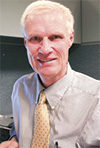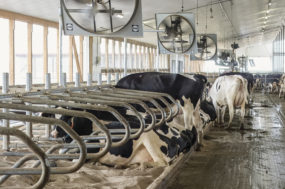Conservation is a group effort. The conservationist and the landowner, and others in both the public and private sector, are collectively working towards planning for and implementing conservation. What does this mean? We may define conservation as a change in the landowner’s behavior toward how a farm landscape is managed, with the expectation that resources like water and soil and air are protected from degradation.
Some months ago I wrote about the Hardin paper, “Tragedy of the Commons.” In the context of conservation, the commons can be the physical resources but also the public good that as a whole benefits from conservation activities.
Our role in NRCS is built upon the premise that a conservationist and the landowner inventory and evaluate the resources on the entire farm landscape, and where improvements can be made, provide the landowner with options he will choose to implement, expecting protection of a resource.
Practically, this means a cover crop to mitigate water erosion of soil, a waste storage facility to avoid winter application of manure on saturated or snow-covered soils and developing a crop nutrient budget so soil-laden nutrients are in reasonable balance with crop uptake, and overt nutrient leaching is minimized.
We base our work on both deductive reasoning and inductive reflection. What does this mean?
Deductive reasoning is straightforward. The science of technical delivery is backed by research work done at land-grant universities and at our USDA agricultural research centers. The scientists and engineers answer research questions, and then the extension officers deliver this new knowledge to the field, including landowners.
The results are published in scientific peer-reviewed journals. In the technical field, therefore, we learn from deducing from what others have already done … what works and what does not work … and in between, too.
What works in Michigan may not work in Maryland but might in Missouri. Of course, the huge benefit now with the Internet, where many extension bulletins are found, enables all of us to quickly find answers to our questions.
Our own USDA-NRCS has a repository of technical publications as well, found on many of our federal websites. Also, our conservation practice standards help guide us through the maze of what conservation practices are used to address particular resource concerns. These are a major part of the conservation planning work in our shop.
The inductive reflection is something quite different. This is art. This reflection is based on years of experience, a gut feeling and the ability to connect disjointed human and physical environments into a working hypothesis that is absolutely unique for each farm and farmer in the landscape.
Others may not agree, but from my perspective as a conservation planner, the inductive reflection as art approach is just as important as deductive reasoning. Much of what we do is completely variable upon open-ended systems.
For instance, the changes in weather from whatever normal is, the changes in pricing from historical prices, the introduction of new technology that sometimes can be game changers – and add to this list the change in owners, especially if a younger person is now making the majority of decisions on a particular farm.
We also fully know that conservation planning is done using a systems approach. We cannot just look at soils or just look at water; these and all the influencing parameters must be included.
And when we are on a farm and visiting a crop field or a pasture, we are inventorying and evaluating what we see empirically that is unique from anywhere else. Yes, there are many similarities, but all site visits are different from others.
Think about these differences this way. If we could categorize conservation planning so that just a fill-in-the-blank approach could be built, then the work could be normalized and streamlined, and even automated.
But we cannot. Yes, we have sideboards to keep us moving and staying in the right direction, but in all the years I have been visiting farms and fields, every one of them is different.
We also know that on the earth’s landscape, most of the inputs are not bound. Solar radiation, water influx and efflux, carbon flowing into and out of the biosphere, and the influence of human management are not mechanistic.
We use the term stochastic, which simply means as we try to predict the expectations for outputs like crop growth or reduction in water erosion (soil stabilization) or antecedent soil moisture content, these unbound parameters cannot be controlled, predicted or completely known to us as technicians. We get a different answer with every analysis.
Yes, we do have some good idea in terms of predicting or forecasting, but sometimes we are wrong. Sometimes we get “black swan” events that are so unusual the event itself is very far away from what was predicted.
For example, there was a tragic early winter snowstorm in the Dakotas early October that was a black swan event. The tragic loss of animals not yet prepared for winter was enormous.
I had the privilege of delivering a conservation discussion yesterday at Michigan State University. For the 20 or so students in the room, many already knew that what they are learning in the classroom is how to take information and convert it into knowledge.
They are on the front end of their careers, and while they have all been on farms and fields, they are relative infants in terms of grasping the bigger picture of a stochastic world and “seeing what is not there.” This, my dear readers, is inductive reflection as art and is based on many years in the field and on the farm.
We cannot train them to understand this, nor can we ever hope to deliver it in the classroom with a lecture, a PowerPoint and handout.
Yes, this is a starting point for deductive reasoning – i.e., how does the thinking person take what is already known and apply to the unique field or farm that is before us? What I am suggesting, however, is that true insight and thought as a critical thinker is found in inductive reflection.
Or as I sometimes write and say: The conservationist as artist understands the statement that he or she “sees and attempts to interpret what is not readily seen by others.”
One important role we have as mentors in a technical field is this: If the conservationist accepts the role that the job is done by using deductive reasoning, that is using data to find knowledge, then we all fail at the true destination.
Here is the destination: understanding that data and knowledge are helpful, but our ultimate goal is wisdom. And this can only come from the inductive art of conservation and conservation planning. PD

Mike Gangwer
Agricultural Scientist
USDA-NRCS




